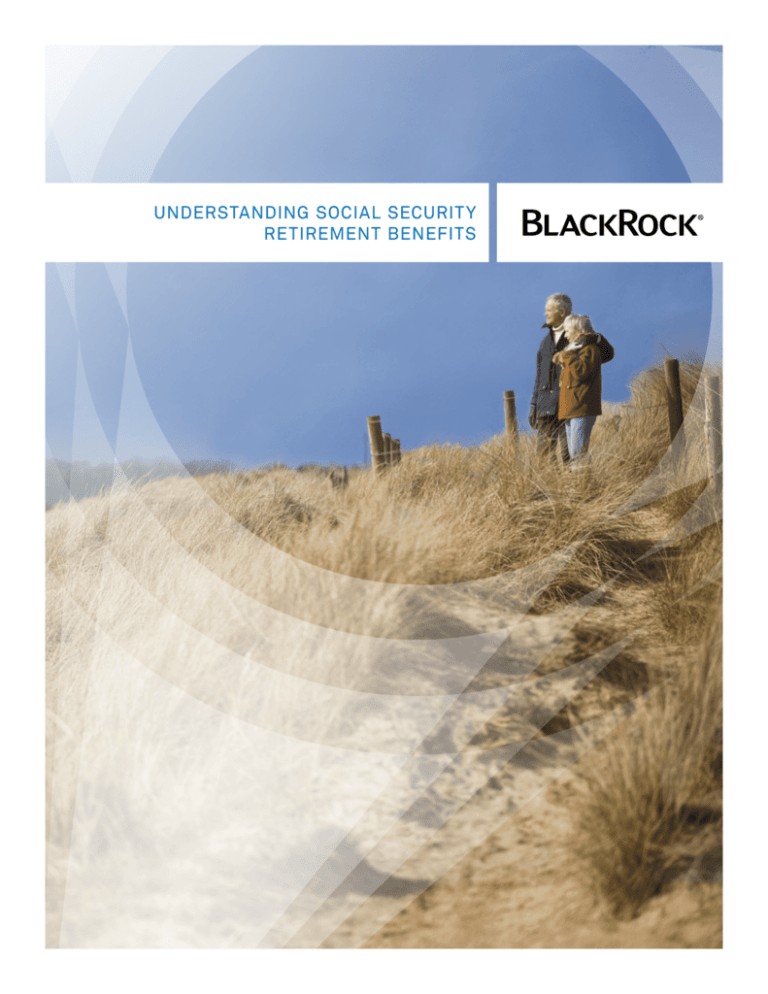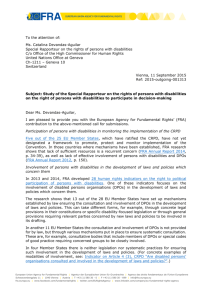
UNDERSTANDING SOCIAL SECURIT Y
RETIREMENT BENEFITS
CONTENTS
Individual Collection Decision..... 3
Popular wisdom suggests jumping at the opportunity to collect
Social Security retirement benefits as soon as possible, which
Qualifying For Benefits............... 3
currently is age 62. While this strategy may have been prudent for
Collecting Benefits...................3-5
} At Full Retirement Age
} Earlier
} Earlier While Working
} Waiting
} Changing your Mind
millions of Americans in the past, longer life expectancies have
Taxation of Benefits.................... 5
Family Collection Decision........6
} Beneficiaries
} Maximum Benefits
} Spousal
} Survivor
} Choosing Between Benefits
} Benefits After Divorce
Impacts of Government
Pensions....................................... 7
changed the face of retirement planning. Waiting to collect Social
Security benefits may well be a more advantageous option. While
there is no one-size-fits-all approach, this much is universally clear:
DECIDING WHEN TO BEGIN TAKING SOCIAL SECURITY BENEFITS
IS AN IMPORTANT AND MULTIFACETED CONSIDERATION that
should be factored into each individual’s broader retirement plan.
In the following pages, we review key details to consider in your
Social Security decision-making. We encourage you to consult
with your financial and tax professionals to ensure your Social
Security strategy complements your overall retirement plan.
Not FDIC Insured • May Lose Value • No Bank Guarantee
[2]
U N D E R S TA N D I N G S O C I A L S E C U R I T Y R E T I R E M E N T B E N E F I T S
Individual
Collection Decision
QUALIFYING FOR BENEFITS
When you work and pay taxes as mandated by the Federal Insurance Contributions
Act (FICA), you earn “credits” toward Social Security retirement benefits. The credits
are based on your annual earnings, with a maximum accrual of four credits per
year. Once you have acquired 40 credits (approximately 10 years of employment),
you are fully insured and eligible to receive retirement benefits. FICA tax (often
displayed on pay statements as OASDI, for old-age, survivors and disability
insurance, tax) is withheld from each paycheck until you have earned up to the
taxable earnings base for the year.
You must be fully insured
(40 credits) to be eligible
to receive benefits.
2016 FICA AMOUNTS
$118,500
$1,260
$5,040 ($1,260 x 4)
Taxable Earnings Base
Earnings Required
for One Credit
Earnings Required for
Max (4) Credits per Year
COLLECTING BENEFITS AT FULL RETIREMENT AGE
Your primary insurance amount (PIA) is the monthly benefit for which you are eligible
at your full retirement age (FRA). FRA varies based on year of birth. Originally age
65, the federal government has increased FRA for anyone born after 1937 in
recognition of longer life expectancies.
FULL RETIREMENT AGE
Year Born
FRA
1937 or earlier
65
1938–1942
65 + 2 months for every year after 1937
1943–195466
1955–1959 66 + 2 months for every year after 1954
1960 +
67
To determine your PIA, the Social Security Administration (SSA) uses your best 35
years of employment to arrive at your Average Indexed Monthly Earnings (AIME). If
you have not worked for 35 years, some of the included earnings may be zero. For
more information, please visit www.ssa.gov. If you continue working after reaching
FRA, the SSA will automatically recalculate your benefits each year you continue
to work. If your current income is greater than any of your previously calculated
“best 35 years,” your benefits will be adjusted upward. The increase generally
will be made in October of the following year, but will be retroactive to January 1.
Your Primary Insurance
Amount is calculated based
on your best 35 years of
employment.
Social Security retirement benefits are automatically modified each year for
Cost-Of-Living Adjustments (COLAs), which are either positive or zero—never
negative. COLAs are based on the Consumer Price Index and have averaged
around 2% over the past 10 years.
[3]
COLAs have averaged
around 2% over the
past 10 years.
HISTORICAL COLAs
6%
5.8%
5
4
3
3.6%
3.3%
2
2.3%
1.7%
1
0
2007
2008
2009
0.0%
0.0%
2010
2011
1.5%
1.7%
0.0%
2012
2013
2014
2015
2016
COLLECTING BENEFITS EARLIER
While your PIA is payable at your FRA, you are entitled to collect benefits as early
as age 62. However, if you choose to collect early, you will permanently reduce the
size of your benefits. Your benefits will not be adjusted upward when you attain
FRA. The amount of your reduction will depend on two factors—your FRA and the
number of months before it that you start collecting. If you begin taking benefits
on your 62nd birthday, you are subject to the maximum reduction. That reduction will
be smaller for each month you delay benefits after age 62 but prior to reaching FRA.
COLLECTION AGE IMPACTS BENEFIT AMOUNT
62
YEARS
OLD
REDUCED BENEFITS
When collecting before
FRA, always consider the
net (after-tax) benefits
you will receive. A working
spouse may cause more of
your benefits to be taxed,
and at potentially higher
tax rates.
FRA
PIA
70
YEARS
OLD
INCREASED BENEFITS
WORKING WHILE COLLECTING BENEFITS PRIOR TO
FULL RETIREMENT AGE
Since Social Security benefits are intended to be supplemental retirement income,
there are consequences to collecting your benefits early (i.e., if you are not retired
and are still receiving wages). If you opt to collect benefits prior to FRA, you are
subject to an earnings test every year until you reach FRA. If your earnings exceed
certain thresholds, the SSA will withhold part or all of your benefits. The earnings
test for individual and survivor benefits looks only at the salary or wages of the
individual collecting early benefits. It does not consider any other type of income,
nor does it consider the salary or wages of a spouse. However, spousal benefits (see
page 6) may take into account both of the spouse’s wages if both are under age 62.
Withheld Benefits
Benefits withheld by the SSA due to early collection will not be refunded. However,
your benefits will be adjusted at FRA to account for the benefits that were withheld.
For example, if your FRA was 66 and you began collecting benefits at age 62, the
SSA would have reduced your benefit by 25%. Assuming you returned to work at
age 64; the SSA may have withheld two years’ worth of benefits by the time you
[4]
U N D E R S TA N D I N G S O C I A L S E C U R I T Y R E T I R E M E N T B E N E F I T S
reached FRA. The SSA would then lessen your 25% reduction
to give you credit for the two years of lost benefits. Your new
reduction would be as if you started collecting benefits at age
64 (13.3% reduction) rather than age 62.
2016 RETIREMENT EARNINGS LIMIT
Under FRA
} $1 of benefits withheld for every $2 in earnings above $15,720
} Earned $25,720 – $15,720 = $10,000 over x 1/2 = $5,000 withheld
WITHDRAWAL OF APPLICATION
FILL OUT A
REQUEST FOR
WITHDRAWAL OF
APPLICATION
FORM
REQUEST IS
Year individual reaches FRA
}$1 of benefits withheld for every $3 in earnings above $41,880 for
months prior to attaining FRA
WAITING TO COLLECT BENEFITS
If you elect to defer collecting benefits beyond your FRA, the
SSA will give you a delayed retirement credit (DRC) for every
month you defer between FRA and age 70, the age at which
your benefits max out. This increase will be in addition to the
annual COLA, if applicable. Depending on your year of birth,
your increase will amount to 7% to 8% annually.
PERCENT OF PIA COLLECTABLE BY AGE
150%
100
100%
108%
116%
124%
Continue to collect benefits
for your Social Security benefits. Importantly, withdrawal
requests must occur within 12 months of commencing benefits
and you are allowed only one withdrawal request in your lifetime.
}Unlimited
125
Repay the SSA
DENIED
} Earned $51,880 – $41,880 = $10,000 over x 1/3 = $3,333 withheld
Month individual reaches FRA and beyond
GRANTED
132%
If any of the benefits repaid were subject to federal income
tax (see next section), you may be entitled to an itemized
deduction on your tax return in the year of repayment. We
encourage you to consult with your tax professional to
ensure your deduction is appropriately applied.
TAXATION OF BENEFITS
About one-third of people who collect Social Security benefits
are required to pay income taxes on them. Individuals with
high total incomes must include up to 85% of their benefits
as income for federal income tax purposes. Special step-rate
“thresholds” on provisional income determine the amount
which you may be taxed. The thresholds for taxation of your
benefits are not currently indexed for inflation.
TAXATION OF SOCIAL SECURITY BENEFITS
Provisional Income =
1
/2 Social Security Benefits + Modified Adjusted Gross Income
75
Collect at
Age 66 (FRA)
Collect at
Age 67
Collect at
Age 68
Collect at
Age 69
Collect at
Age 70
Assumes full retirement age of 66 and individual born in 1943 or later
CHANGING YOUR MIND—
APPLICATION WITHDRAWAL
If you start collecting Social Security benefits and change your
mind you can file a “Request for Withdrawal of Application” form
with the SSA. Assuming your withdrawal request is granted, you
must repay the SSA all of the payments you and anyone else
collected based on your work history. There is no penalty or
interest on the amount repaid and you may subsequently refile
SINGLE
$0-$25K
Above
$25K
0%
of Benefits
are Taxable
0 50
-
of Benefits
% are Taxable
Above
$34K
MARRIED,
FILING
JOINTLY
$0-$32K
Above
$32K
Above
7 85%
-
of Benefits
are Taxable
$44K
[5]
Family
Collection Decision
SPOUSE
Eligible if:
} Age 62 or over
}Any age if caring for
your child who is
under 16 or disabled
before age 22
} Age 60 if widower
CHILD
Eligible if:
}Under age 18, or
up to age 19 if in
high school
}Any age if disabled
before age 22
BENEFICIARIES ENTITLED TO COLLECT OFF YOUR BENEFITS
Once you start collecting, certain other individuals may be entitled to collect
benefits based on your work history. If you have been married for at least one year,
your spouse may be entitled to collect spousal benefits. Under certain conditions,
your children also may be entitled to benefits.
MAXIMUM FAMILY BENEFITS
The amount of benefits that members of a family may receive on the earnings
record of one worker is limited. The limit varies between 150% and 188% of the
worker’s PIA. If the total benefits due to your spouse and children push your
family’s benefits above the limit, their benefits will be reduced proportionately to
bring the total within the limit. Your benefits will not be affected. Any benefits
payable to an ex-spouse (addressed later) are not included in the family maximum.
COLLECTING SPOUSAL BENEFITS
If you are married to an individual who is collecting Social Security retirement
benefits and you are at least age 62, you may be entitled to collect spousal benefits.
Spousal benefits will be equal to 50% of your spouse’s PIA if you collect benefits at
FRA or later. If you are entitled to your own benefits and your PIA is less than 50%
of your spouse’s PIA, spousal benefits will be paid in addition to your own. These
combined benefits will equal 50% of your spouse’s PIA, assuming you start
collecting both benefits at FRA or later.
COLLECT MORE INCOME BY COMBINING SPOUSAL AND
INDIVIDUAL BENEFITS
AGE 66
(FRA)
AGE 62
ALEX | PIA: $600
own
spousal
$ 450
$ 350
-25%
-30%
own
spousal
$ 600
$ 500
own
spousal
+32%
AGE 70
JORDAN | PIA: $2,200
$ 792
$1,100 Max
$ 308
= $ 800
= $1,100(MAX)
= $1,100(MAX)
Jordan must file and collect in order for Alex to collect spousal.
[6]
U N D E R S TA N D I N G S O C I A L S E C U R I T Y R E T I R E M E N T B E N E F I T S
Collecting Spousal Benefits Early
If you collect spousal benefits prior to your FRA, your
adjusted spousal benefits (amounts in addition to your
own benefits) will be reduced. Your spouse’s collection
age has no impact on your spousal benefits.
Waiting to Collect Spousal Benefits
Unlike your own benefits, spousal benefits are not subject
to guaranteed annual increases if you defer collecting
them beyond FRA. Spousal benefits are at their maximum
when you reach FRA, so there is no advantage to be gained
by deferring collection.
COLLECTING SURVIVOR BENEFITS
If you have been married for at least nine months and
your spouse passes away, you may be entitled to survivor
benefits. If you remarry before age 60, survivor benefits
will not be paid unless the subsequent marriage ends.
Remarriage after age 60 does not prevent or stop entitlement
to benefits. The amount of your survivor benefits depends
on when your spouse began taking benefits. If the death
occurs prior to your spouse collecting benefits, your survivor
benefits will equal 100% of your spouse’s PIA when you
attain FRA. If your spouse was collecting benefits at the time
of his or her death, your survivor benefits will equal his or
her actual benefits, assuming you have attained FRA.
The only exception is if he or she was collecting benefits that
were reduced more than 17.5%. In that case, your survivor
benefits will be 82.5% of your spouse’s PIA. The survivor
benefits, if higher, will replace your other benefits.
Collecting Survivor Benefits Early
You can collect survivor benefits as young as age 60. If you
collect at age 60, your survivor benefits will be reduced by
up to 28.5%.
CHOOSING BETWEEN BENEFITS
If you are entitled to both individual and survivor benefits,
you can choose to begin collecting one and then switch to
the other at a later date. It is possible to collect reduced
survivor benefits at age 60, and then convert to your own
unreduced benefits at FRA or later. You also have the
option to collect individual benefits and then switch to
survivor benefits.
DECISION OF INDIVIDUAL BENEFITS AFFECTS
SURVIVOR BENEFITS
HIGHER EARNER’S
MONTHLY
BENEFITS
70
YEARS
OLD
$2,904
HIGHER EARNER’S
MONTHLY
BENEFITS
FRA
LOWER EARNER’S
SURVIVOR
BENEFITS
$2,904
LOWER EARNER’S
SURVIVOR
BENEFITS
$2,200
$2,200
62
LOWER EARNER’S
SURVIVOR
BENEFITS
HIGHER EARNER’S
MONTHLY
BENEFITS
YEARS
OLD
$1,650
$1,815
Assumes higher earner has full retirement age of 66 and PIA of $2,200. Assumes lower
earner has attained FRA prior to collecting survivor benefits.
SPOUSAL AND SURVIVOR BENEFITS
AFTER DIVORCE
If you are not married but previously had been married to the
same individual for at least 10 years, you may be entitled to
collect spousal and/or survivor benefits based on your exspouse’s work history, as described earlier. To collect spousal
benefits you and your ex-spouse must be at least 62. You are
not required to wait until your ex-spouse files for benefits.
IMPACTS OF GOVERNMENT PENSIONS
If you worked for an employer who did not withhold FICA
taxes from your salary, such as a government agency, the
pension you receive based on that work may reduce your
Social Security retirement benefits. This reduction, part of
the windfall elimination provision (WEP), affects individuals
who earned a pension in any job where FICA taxes were not
paid and who worked in other jobs long enough to qualify for
Social Security retirement benefits.
[7]
The Government Pension
Offset reduces your
spousal and/or survivor
benefit amount received if
you earned a government
pension where FICA taxes
were not paid.
Individuals who receive a pension from a federal, state or local government based
on work where FICA taxes were not withheld may also have the spousal and/or
survivor benefits they collect reduced. Social Security benefits will be reduced by
two-thirds of the government pension.
GOVERNMENT PENSION OFFSET EXAMPLE
Pension $1,500 X 2/3 = Offset $1,000
Spousal Benefits
$1,250
-$1,000 Offset
Survivor Benefits
$2,500
-$1,000 Offset
$250
$1,500
GETTING STARTED
Clearly, there are many considerations when it comes to claiming Social Security
benefits. What works for others may not be your best strategy, and vice versa.
Being informed is the first step toward good decision-making. Visit the Social
Security Administration’s website at www.ssa.gov to download your Social
Security Statement. Meet with your advisor to review how a Social Security
strategy fits into your financial plan.
Want to know more?
blackrock.com
Sources: BlackRock; Social Security Administration; Internal Revenue Service. Please see the Social Security Administration’s website at www.ssa.gov for more information, restrictions
and limitations about Social Security benefits.
This material is provided for educational purposes only and does not constitute investment advice. The information contained
herein is based on current tax laws, which may change in the future. BlackRock cannot be held responsible for any direct or
incidental loss resulting from applying any of the information provided in this publication or from any other source mentioned.
The information provided in these materials does not constitute any legal, tax or accounting advice. Please consult with a
qualified professional for this type of advice.
©2016 BlackRock, Inc. All Rights Reserved. BLACKROCK is a registered trademark of BlackRock, Inc.
or its subsidiaries in the United States and elsewhere. All other trademarks are those of their respective owners.
Lit. No. SS-BRO-0116
2883A-RET-1114 / USR-7727





